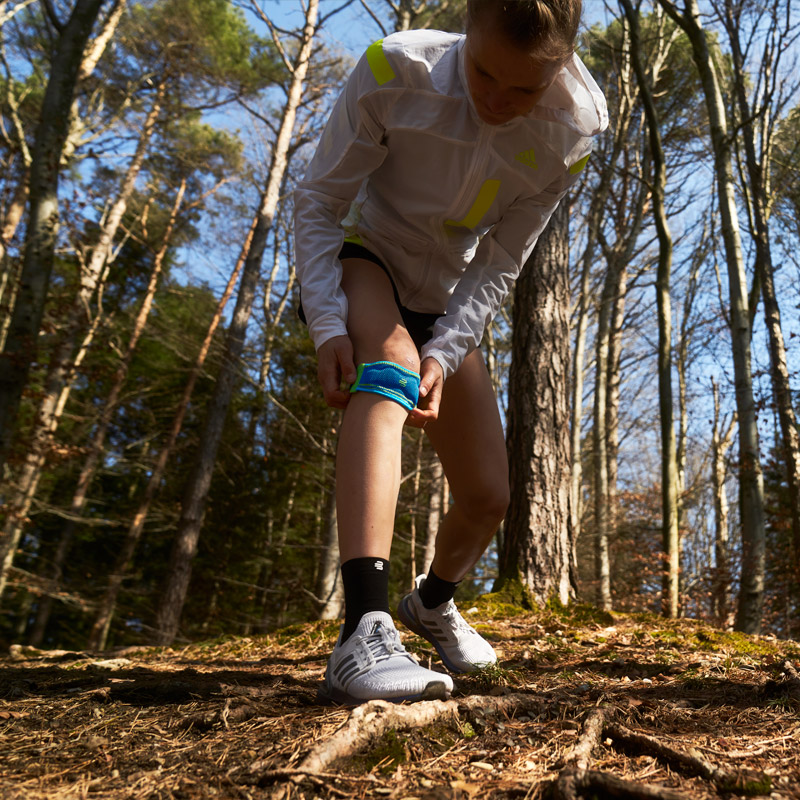Quickly return to running with the Sports Patella Strap
A piercing pain at the front of the knee or below the kneecap is often an indication of patellar tendonitis, also known as Jumper’s Knee. But as a runner, don’t let this term confuse you. Depending on your running and training style, you can be affected just as much.
Symptoms: What does Patellar Tendonitis feel like?
When it comes to Jumper’s Knee, you might feel pain in front of or below the knee cap. This pain is often caused by inflammation of the patellar tendon.
Other symptoms may include:
- Pain while, running, jumping, walking or climbing stairs
- Swollen or stiff knee
- Pain while bending and stretching the knee
Do not take knee pain lightly. If you ignore an irritated patellar tendon and continue to subject your knee to excessive strain, it may even lead to a tear or partial tear of the tendon.

What causes Patellar Tendonitis?
The patellar tendon connects the kneecap to the shin bone. As soon as the knee joint moves, strain is put on the patellar tendon – that means it has to withstand a lot of pressure. If the excessive strain continues, over time leading to irritation or inflammation of the patellar tendon (patellar tendonitis). If this irritation does not subside by itself after a short time but becomes chronic instead, wear can cause “degenerative” changes, leading to patellar tendinopathy.
In volleyball or basketball players, it’s the quick starting and stopping movements, sudden changes of direction and jumps that can irritate the patellar tendon – therefore called “jumper’s knee”. Running also consists of lots of little jumps, which is why it's not uncommon for runners to develop.
If the knee is regularly subjected to too much strain during running, for example caused by inappropriate mechanical stress, this can also lead to an irritation of the patellar tendon. Perhaps you approached your training too enthusiastically and overestimated your strength; perhaps you spent too much time in hilly terrain or running on a very hard surface, such as asphalt, for too long and often. Also, have a look at your running shoes – if they are no longer okay, they cannot adequately fulfil their function and should be replaced.
Be especially careful if you have already been diagnosed with reduced elasticity of the patellar tendon, a high-riding kneecap (patella alta) or congenital ligament weakness; in these cases, you are more susceptible to patellar tendonitis.
When to see a doctor
Make sure that you get your physician to confirm whether you really are suffering from patellar tendonitis – or whether your pain is caused by something else. Consult a doctor if your knee or pain does not subside within a few days or you suspect trauma to the knee.
How do you treat Patellar Tendonitis?
Home remedies
- Rest to avoid excessive strain - RICE Therapy (Rest, Ice, Compression, Elevation).
- Reduce stress on the patellar tendon with the Bauerfeind Sports Knee Strap to address overload issues.
- Take over the counter anti-inflammatory medication (NSAIDs) such as Ibuprofen to reduce pain and inflammation
Advanced therapy
- Physical therapy, with stretching and massage, also boosts the healing process.

Sports Knee Strap
Guides and relieves the patella tendon during activity. Improves the knee’s sensorimotor function.

Recovery Time from Patellar Tendonitis
In cases of acute patellar tendonitis, it is primarily rest and relief that help. Depending on the severity of the irritation, you should take a break from running of between six and twelve weeks and take it easy on your knee joint.



